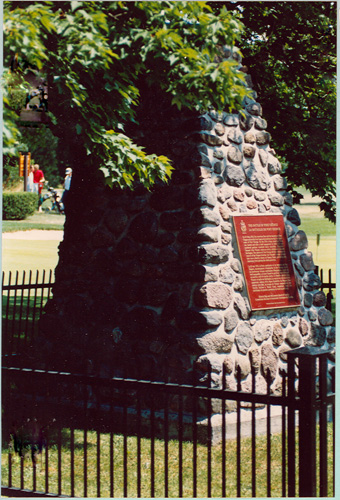Battlefield of Fort George National Historic Site of Canada
Niagara-on-the-Lake, Ontario

General view of the HSMBC cairn and plaque
© Parks Canada Agency/Agence Parcs Canada, 1989
Address :
Queen Street, Niagara-on-the-Lake, Ontario
Recognition Statute:
Historic Sites and Monuments Act (R.S.C., 1985, c. H-4)
Designation Date:
1921-05-21
Dates:
-
1921 to 1921
(Construction)
-
1813 to 1813
(Significant)
Event, Person, Organization:
-
Battle of Fort George
(Event)
-
War of 1812
(Event)
-
Brigadier-General John Vincent
(Person)
-
General Henry Dearborn
(Person)
Other Name(s):
-
Battlefield of Fort George
(Designation Name)
-
Battle of Fort George
(Other Name)
Research Report Number:
2002-080, 2008-SDC-021
Plaque(s)
Existing plaque: corner of Newark and Queen Street, Niagara-on-the-Lake, Ontario
On 25 May, 1813, the American fleet and the batteries at Fort Niagara across the river began a devastating two-day bombardment of Fort George. On the 27th a large American force was landed and after a brief engagement in which his outnumbered garrison sustained heavy casualties, Brigadier-General John Vincent made an orderly withdrawal towards Burlington. The capture of Fort George left the Americans in control of the Niagara frontier; but Vincent's troops a week later won a decisive victory at Stoney Creek, preventing the Americans from gaining the whole peninsula.
27th May, 1813
Landing Place of Invading Troops
Here was fought the Action on that day
PRO PATRIA
In memory of
Lieutenant james Drummie, 8th Regiment, Captain Andrew Liddle and Ensign William McLean, Glengarry Light Infantry, and the non-commissioned officers and men of the Royal Artillery, 8th Regiment, 49th Regiment, Glengarry Light Infantry, royal Newfoundland Regiment and Lincoln Militia, killed in this battle.
Description of Historic Place
Battlefield of Fort George National Historic Site is located near Fort George National Historic Site of Canada in Niagara-on-the-Lake, Ontario. The rolling open landscape near the shore of Lake Ontario at Two Mile Creek was the site of one of the fiercest and most important battles of the War of 1812. There are no extant remains of the 1813 battle between American invading forces and British regulars and Canadian militia; however, a cairn and plaque erected by the Historic Sites and Monuments Board of Canada (HSMBC) marks the northeast corner of the battle site. Official recognition refers to the irregular polygon encompassing the battlefield.
Heritage Value
Battlefield of Fort George was designated a national historic site of Canada in 1921 because: it gave the American army temporary control over the entrance to the Niagara River and blocked vital British supplies being shipped to the western posts.
The heritage value of the Battlefield of Fort George lies in the landscape, which was witness to a significant battle fought on Canadian soil. The Battle of Fort George, which took place from May 25 to 27, 1813, constituted some of the fiercest fighting during the War of 1812, as British and Canadian forces attempted to prevent the American landing at Two Mile Creek. Victory in the Battle of Fort George permitted the Americans to gain a toehold on the Niagara Peninsula forcing the British and Canadian forces to temporarily abandon the peninsula. Despite their victory, the Americans were checked at the Battle of Stoney Creek, and were ultimately overcome in Niagara (now Niagara-on-the-Lake), which they abandoned and burned in December 1813.
Source: Historic Sites and Monuments Board of Canada, Minutes, 1921.
Character-Defining Elements
Key elements which contribute to the heritage value of this site include: its location near Fort George National Historic Site of Canada at Niagara-on-the-Lake, Ontario; its setting on an open, rolling landscape near the shore of Lake Ontario at Two Mile Creek; the surviving landscape features significant to the conduct of the battle including the American landing site, the ravines of One Mile and Two Mile Creeks, Four Mile Pond, the beach with its steep and crumbling bank, as well as the flat plateau above the bank with its mixture of forest and clearing; the presence of Carolinian forest and other plants native to the Niagara area; the plaque and cairn erected by the Historic Sites and Monuments Board of Canada, surrounded by a fence; the integrity of any surviving or as yet unidentified archaeological remains relating to the battle which may be found within the site in their original placement and extent; viewscapes across Lake Ontario.